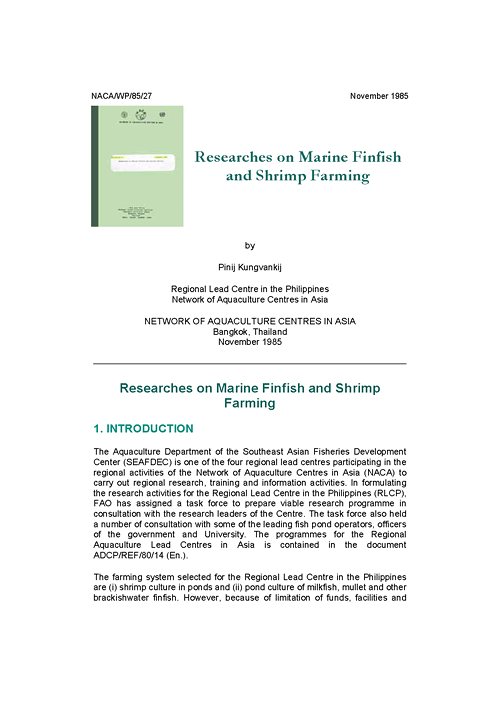Research on Marine Finfish and Shrimp Farming
1 November 2005 | Pinij Kungvankij | 658 Downloads | .pdf | 537.73 KB | Marine finfish, Shrimp, Philippines
This is a historical report describing the establishment of a marine finfish and shrimp aquaculture research programme by the SEAFDEC Aquaculture Department at its Tigbauan station. The report describes the facilities that were established, with diagrammes of the facility layout and list of personnel. It also summaries research findings and makes recommendations on future research directions, including on broodstock manturation, development of larval and compound feeds, health and extension of technology.
The Aquaculture Department of the Southeast Asian Fisheries Development Center (SEAFDEC) is one of the four regional lead centres participating in the regional activities of the Network of Aquaculture Centres in Asia (NACA) to carry out regional research, training and information activities. In formulating the research activities for the Regional Lead Centre in the Philippines (RLCP), FAO has assigned a task force to prepare viable research programme in consultation with the research leaders of the Centre. The task force also held a number of consultation with some of the leading fish pond operators, officers of the government and University. The programmes for the Regional Aquaculture Lead Centres in Asia is contained in the document ADCP/REF/80/14 (En.).
The farming system selected for the Regional Lead Centre in the Philippines are (i) shrimp culture in ponds and (ii) pond culture of milkfish, mullet and other brackishwater finfish. However, because of limitation of funds, facilities and technical manpower, research will be concentrated on priority commodities of the country which also are of regional interest.
While noting the effort of IDRC in establishing breeding and culture technology for milkfish, the Centre focuses its initial attention and effort on the farming of shrimp in brackishwater ponds and culture of other brackishwater finfish (seabass and grouper). The selection of shrimp is due to its high market value and its economic importance to the shrimp cultivated in the various tropical and sub-tropical Asian countries. The rapid decline of supply from the wild has led many countries to launch massive programmes to culture the species which has a lucrative export value. However, appropriate farming technology has not been fully developed resulting to frequent shortage of feed supply, poor harvest and in some cases collapse of production farms.
Seabass and grouper are commercially important fish species in countries of the tropical and sub-tropical areas of the western Pacific and Indian oceans. Seabass and grouper culture in ponds and cages have been practiced in the Southeast Asian region and have been considered as having high potential for aquafarming in tropical Asia-Pacific region. The limitation of seabass and grouper farming is in the dependency of the industry on the natural fry stocks from the wild. The successful spawning of these species in captivity have stimulated wide interest. However, these are carnivorous species and would require suitable feeds such as trash fish or compound feed for their cultivation. Moreover, the techniques on seed production and grow-out farming in ponds and cages as well as the availability of economic analysis are yet to be refined to reduce existing production cost.
The development of the aquafarming industry can only be accelerated based on appropriate production technologies. The major research approach of the lead centre is therefore to concentrate its research effort in the filling up of technological gaps of the culture technology of shrimps and finfish as well as the verification and testing of technology generated before application by fish growers in the region. The Center adopts production oriented, interdisciplinary research approach with the intention of generating appropriate technologies within the shortest possible time (Fig.1).
Since the establishment of the center in late October 1980, the initial phase was concentrated on the recruitment of international research staff, establishment of infrastructure and procurement of equipment while some research work had begun simultaneously with infrastructure development. Full scale research activities were not undertaken until the beginning of 1983.
Creative Commons Attribution.

